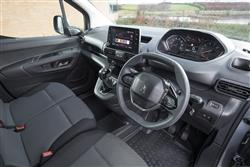THE PERFECT PARTNER? (some text hidden) --NONE--
By Jonathan Crouch
Introductionword count: 107
Peugeot's Partner Van is a compact LCV that built on two decades of ruggedness and quality in this much improved third generation form. At the wheel, you get a unique 'i-Cockpit' cab design, plus there's clever technology that aimed to set a fresh commercial segment benchmark in this class, along with a more efficient BlueHDi diesel engine range. The larger of the two body shapes got a longer wheelbase for extra space and you'll appreciate the clever cabin configurability. This LCV was voted International Van of the Year at its launch - for good reason. Here, we look at this MK3 model in its original 2018-2023-era form.
Modelsword count: 9
compact van (1.5 BlueHDi diesel / Electric - EV)
Historyword count: 358
The Partner nameplate first arrived in the LCV segment in 1996, with a second generation version launched in 2008, then updated in 2015. Building on this strong heritage, this MK3 Partner Van - launched in late 2018 - marked a thorough renewal of this best-seller. As before, it's the kind of model you choose if your business needs a compact LCV that isn't quite as small as a modern city van-sector model would be. Vehicles like that are based on superminis: Partner-type models, in contrast, sit upon the more spacious platforms originally developed for family hatchbacks or small MPVs. Back in 2018, there were certainly plenty of vans of that type - most notably perhaps, this Peugeot's near-identical design stablemates, Citroen's Berlingo and Vauxhall's Combo. Beyond what was then called the PSA Group, this Partner had to directly take on strong-selling contenders like Ford's Transit Connect, Fiat's Doblo Cargo and Volkswagen's Caddy, along with two further brand-shared designs, the Renault Kangoo and the Mercedes Citan. Keen for the Partner to stand out from this crowd, Peugeot equipped it with something that back in 2018 had never been seen on a van before - its clever 'i-Cockpit' instrument binnacle and steering wheel package, something that had been used on the company's passenger car models to improve handling feel and reduce driving fatigue. It gave this Partner something to set it apart from Citroen and Vauxhall design stablemates that, like this model, aimed to bring a fresh level of cutting-edge technology to this part of the LCV segment. Like them, this van offered a new 1.5-litre BlueHDi diesel engine and the availability of a slick-shifting new EAT8 auto gearbox that Peugeot hoped would suit urban-based users. The stiffer EMP2 platform used by this MK3 design was paired with electric power steering. And new technology included a clever surround rear-vision camera. Plus, as before, there were a couple of body lengths and two or three seat options, plus a Crew Van variant. A full-electric version arrived in 2021. Diesel and EV versions of this Partner sold in this form until early 2024, when this design was updated with a facelifted model.
What You Getword count: 399
In place of the previous design's rather apologetic look, this MK3 Partner took the opportunity provided by the installation of its fresh EMP2 platform to deliver a stronger, more dynamic and robust design with shorter overhangs for better manoeuvrability and a higher bonnet for greater rigidity. At the wheel it's not just the unique 'i-Cockpit' dashboard layout that makes it feel different from the previous generation model; everything's of much higher quality than was the case with the MK2 model, with a more horizontally-orientated architecture and smarter materials on the dashboard, the centre console and the doors. There was a bit of extra optional high-tech - the 'Surround Rear Vision' screen for instance - plus plusher versions got a much more sophisticated centre-dash infotainment screen, which was 8-inches in size. The seats were much improved too - particularly the driver's chair, which can feature Peugeot's particularly supportive 'Advanced Comfort' design. And there's plenty of cabin practicality. If you were to add up the capacity of all the different nooks and crannies available within the cab of this Partner van, you'd arrive at a figure of 113-litres. Time to focus on practicality. As ever, there are two Partner body shapes to consider - the 4.4m-long 'Standard'-length version and a lengthier 4.75m 'Long' variant which in MK3 form gained a proper long wheelbase platform, so can take more inside. Even the 'Standard'-shape Partner model has a load area big enough to swallow a couple of Euro pallets (thanks to a useful 1,229mm of width between the wheel arches) and can offer 3.3m3 of carriage capacity and 1,817mm of load space length. The bigger 'Long' version can increase those figures to 3.9m3 of capacity and 2,167mm of load space length. Either way, there's 1,236mm of interior height. With both body shapes, you can extend the capacity by an extra 0.5m3 by using the clever 'Multi-Flex' modular bench seat package that was standard above entry-level trim. This will enable you to flatten the outer passenger seat into the floor and push through longer items into the cab. What else? Well payload capacity is rated at either fractionally above or fractionally below a tonne - which is class-competitive. As for efficiency, well with the volume BlueHDi 100 powerplant that most Partner van buyers will choose, you're looking at between 66 and 68mpg on the combined cycle and somewhere between 109 and 112g/km of CO2.
To see the full road test text contact us on 0330 0020 227
Pictures (high res disabled)

.jpg)
|
.jpg)
|
.jpg)
| |||
.jpg)
|
.jpg)
|
.jpg)
| |||
.jpg)
|
.jpg)
|
.jpg)
| |||
.jpg)
|
.jpg)
|
.jpg)
| |||

|
Scoring (subset of scores)
Category: Vans
| Performance | |
| Handling | |
| Comfort | |
| Space | |
| Styling, Build, Value, Equipment, Depreciation, Handling, Insurance and Total scores are available with our full data feed. | |



